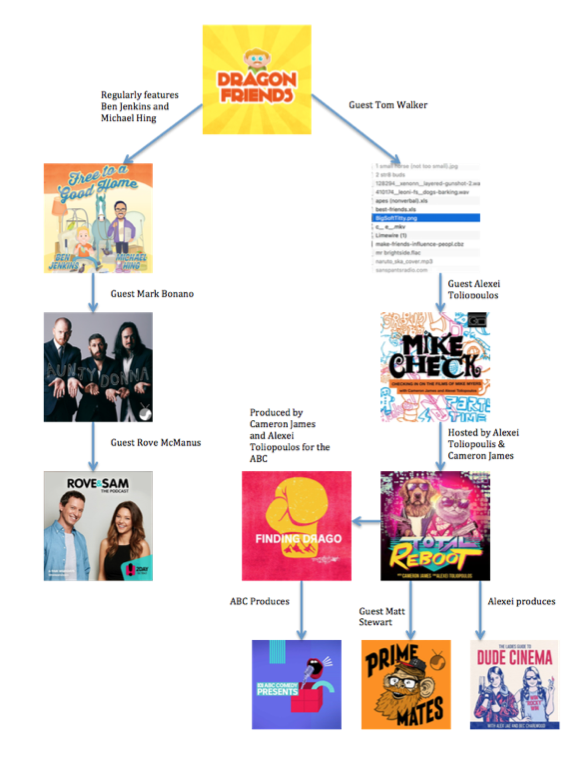by Dylan Dagenais
How does one discover podcasts? As someone in the industry I get asked this all the time. Is it Subway advertisements? Social media? Podcast hosts always want the key to getting people to listen.
The simple answer is that the number one way that people decide what podcasts to listen to is listening to other podcasts.
Above is a sample of how a listener comes to find the podcasts that they like. I was introduced to the podcast improv comedy Dragon Friends by my sister and by listening to that came across every podcast on this chart.
Let’s further breakdown how a listener comes to their next podcast obsession.
1. GUESTS
Guesting on a podcast is the number one way to get new listenership. The good news is that podcast hosts are always looking for guests, as often the formula of the same one to five hosts every episode gets stale.
A good example is the Shockwaves film podcast. Every episode features an interview with a film director, writer, actor or icon and gives it the feel of an edgy news show.
Another example is Michael Hing and Ben Jenkins’s podcast Free to a Good Home, a comedy podcast based around internet classified ads. Though some episodes feature only the dynamic of the two hosts, most episodes have a guest come in to bring their own humor, stories and perspective to the topic.
2. PLUGS
A plug is more or less a shoutout to a podcast that a host is friends with or works with in some capacity. The fast-growing company Luminary uses this technique to keep their listeners listening to their podcasts. As a subscription service much like Netflix, the idea is to have a ton of great content to work through. The podcast we work with, On Second Thought with Trevor Noah, is one of these programs and Luminary’s catalogue of shows keeps their listeners discovering.
This can be within a network/company or just among podcasts hosts with similar goals.
3. PREVIOUS LISTENERSHIP
Many podcasters have more than one podcast in their time. Cross-promotion is key and especially when ending one podcast it is a good strategy to have the next lined up and ready to go. That way listeners can transition seamlessly from one listening experience to another.
4. PRODUCERS
Line producers tend to work on a lot of podcasts. For example, Leon Neyfakh broke open the podcast world with his podcast Slow Burn and now works on both Trevor Noah’s show and a new podcast Fiasco. Alexei Toliopoulos has been a podcaster for several years, but grew his listenership after doing the slightly more mainstream comedy/investigative podcast Finding Drago for ABC’s podcast network. The ABC audience enjoyed his narrative voice in Drago and then went back and found goofier podcasts like The Mike Check. In addition to this, he went on to produce The Ladies Guide to Dude Cinema, now enjoying a great listenership from fans of their work and Alexei’s.
Having a producer who has podcast experience is a sure feather in the cap of any podcast, not only for their knowledge of the form but also for the listeners that follow their work.
5. LIVE PODCAST EVENTS
A podcast with a devoted following often has a live event at some point and records a “live podcast”. Grouping these events is becoming more and more frequent, to the point where we may see podcast festivals in the future, much like Ozyfest right here in New York. These types of events work like a concert; if you like listening to it it’s exciting to see it live. The opportunity for discovery and building listeners is huge and the added bonus is having live-recorded content that can be used as exclusive content for your podcast.
Podcasts are just coming into their own as a free-standing industry, and it is important that the listener have more and more content for their commutes, road trips and leisure time. Make sure your podcast is next in the queue.







